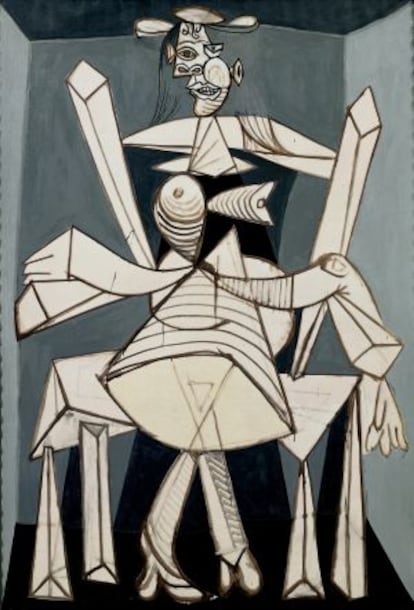Exploring Picasso’s shades of gray
Shows in Madrid and New York uncover nuances of ‘Guernica’ and other works

Pablo Picasso’s Guernica is an inexhaustible artwork. Seventy-five years have gone by since the artist painted it inside the attic at Rue des Grands Augustins 7, commissioned by the Republic for the Spanish pavilion at the 1937 Paris International Exposition.
The creation of the painting is one of the best-documented ever — not just because of the numerous sketches that survive, but also because Dora Maar, a photographer who was Picasso’s lover at the time, captured every stage of the project with her camera.
Since then, the adventures and mishaps experienced by Guernica have regularly made the headlines, reflecting the undying power of this symbolic mural about war, suffering and the senselessness of destruction.
Now, two separate exhibitions an ocean apart remind us of the continuing relevance of Guernica: Picasso Black and White at the Guggenheim in New York and Encuentros con los años 30 (Encounters with the 1930s) at the Reina Sofía Museum in Madrid, where it is on permanent display.
These will be the biggest shows of the season at both art centers, although neither one delves directly into the painting. Instead, the Guggenheim and the Reina Sofía walk symbolically around Guernica, placing it in the context of Picasso’s entire oeuvre and of the turbulent period of history in which it was made.
The Guggenheim in New York uncovers a side of Picasso’s art that had mostly gone unnoticed: the paintings and sculptures he did exclusively in black, gray and white.
“Picasso used black and white throughout his entire career,” says the curator, Carmen Giménez, a Spaniard who is in charge of the museum’s 20th-century holdings. “The entire war is in black and white, but he also addressed other issues using these tones.”
The exhibition brings together 118 pieces made between 1904 and 1972, which practically encompasses Picasso’s entire career. There are scenes depicting sadness and melancholy, as well as the suffering and terror of war, but there are also examples of his Cubist work, still lifes, portraits, studies of other artists, erotic scenes — many of them painted in his old age — and a great many sculptures.
“When Picasso wanted to do something important, he did it in black and white,” says Giménez. “On many occasions he used it for transition works between different periods. I think that black and white is where he expresses himself best, where he is clearer.”
“Many of these [artworks] were part of his private collection until his death, and have hardly been seen in public. Picasso reserved his favorite paintings for himself, which leads us to think that these works in black and white had a special meaning for him,” adds the curator.
Giménez believes that black and white helped Picasso create complicated compositions, where color might have prevented him from thinking clearly. He did this in analytical Cubism, but also “at times of emotional conflict with women and with wars. Picasso suffered a lot during the First and Second World Wars, and anything that presaged an armed conflict was very painful to him.”
Picasso used to paint at night, and that gave him a particular perception of light and shadow, bringing it close to photography. That is why he once told the photographer George Brassaï: “The light I have at night is magnificent, I even prefer it to natural light. You should come over one night to see it. It is a light that highlights each object with shadows, tracing its circle around the canvas and projecting on to the beams; you can find it in most of my still lifes, almost all of which I painted at night.”
Yet there is one conspicuous absence in this exhibition, and that is precisely the black-and-white Guernica itself, which cannot be moved from its current location.
“There are marvelous paintings by Picasso, like Les Demoiselles d’Avignon, but Guernica is his masterpiece in black and white,” admits Giménez. “He managed to make it a painting for all times. It suggests the Spanish tradition of Goya and Velázquez. You cannot say that it’s the Spanish Civil War — it could be any war, like the war in Syria today or any other future war. It is timeless and therein lies its enormous power.”
If exploring Picasso’s black-and-white work helps gain a better understanding of Guernica, the Madrid show Encuentros con los años 30 explores the circumstances that brought it about.
“The decade of the 1930s is one of the most important ones in terms of the development of modern art,” explains Jordana Mendelson, general curator of the Madrid show. “It’s not just because that decade produced many of the avant-garde ‘isms’: abstraction, realism, surrealism... but also because of the political events taking place then. In the art histories told since then, we’ve somewhat lost the perspective of how important Spanish art was at the time. In this exhibition we try to review the decade with our eyes set on the complications of the moment, without attempting to gloss over them or make things sound easier than they were. [...] We revisit Guernica not just as a masterpiece, but as part of a story with many circumstances to take into account.”
The show takes up two floors of the museum, around 2,000 square meters. One of the floors houses the actual painting, not as an isolated artwork but in relation to everything that happened in Spain in the 1930s, including the Republican government and the Civil War.
Besides painting and sculpture, there will also be illustrated work, propaganda, posters, drawings, photographs and films on display. There is also work on loan from international museums, including pieces by Max Beckmann, Piet Mondrian, Kandinsky, Tanguy, Man Ray, Miró, Moholy-Nagy, Klee and Dalí.
Picasso Black and White. Until January 23 at Guggenheim New York. www.guggenheim.org. Encuentros con los años 30. Until January 7 at Museo Reina Sofía, Madrid. www.museoreinasofia.es







































